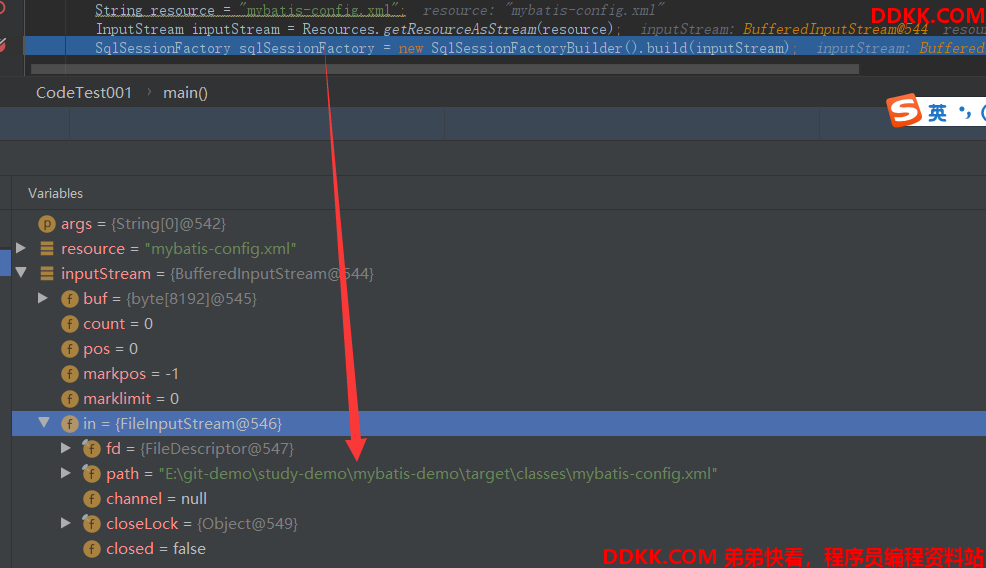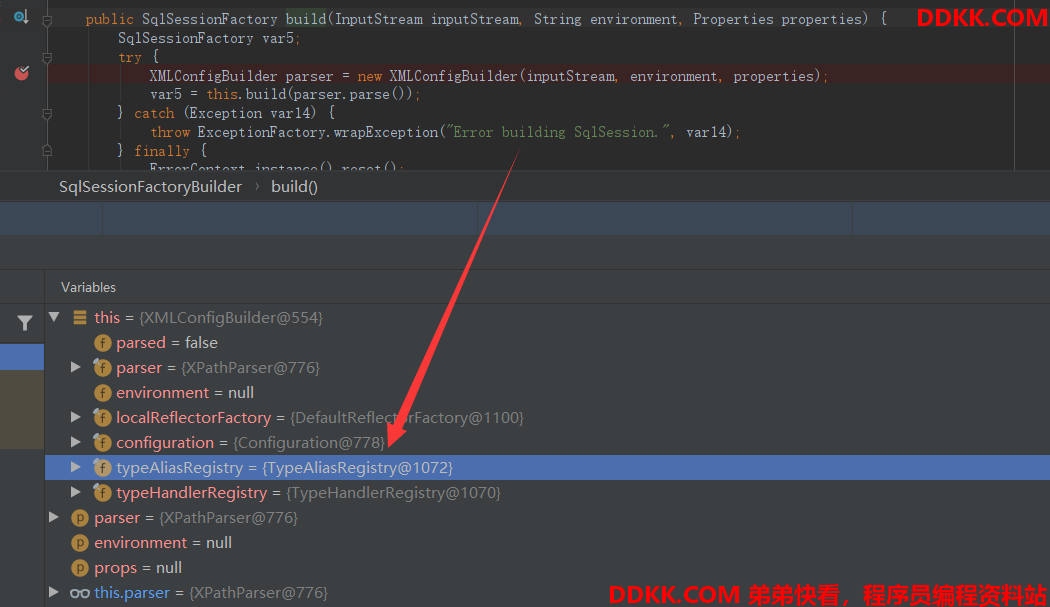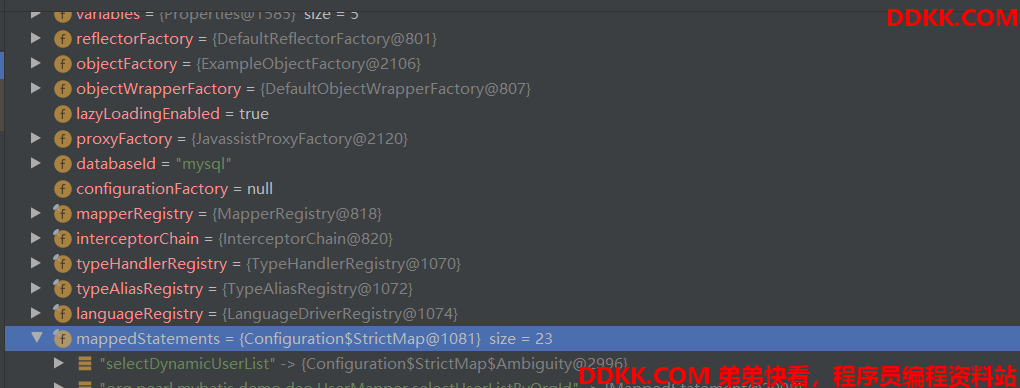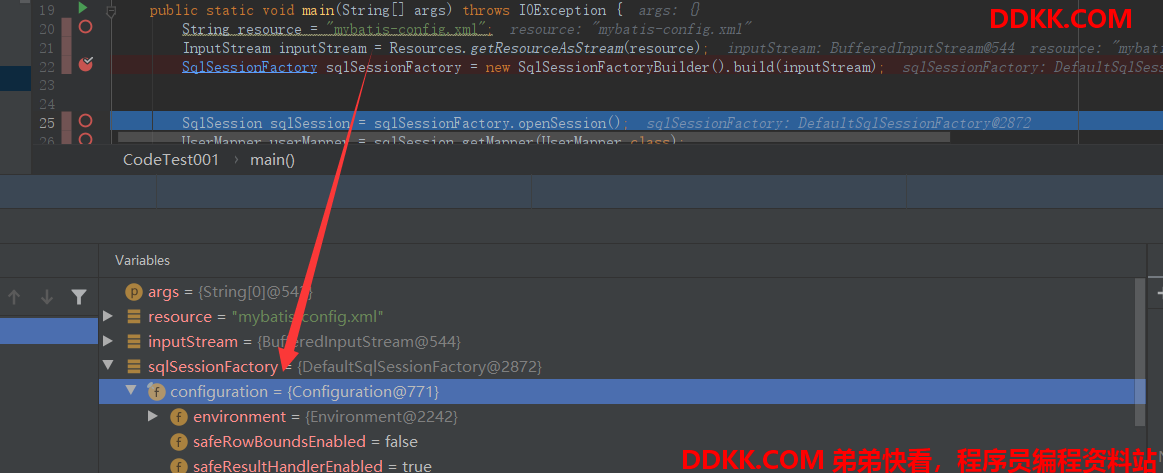功能架构图
Mybatis的功能架构分为以下几层:
- API接口层:提供给外部使用的接口API,开发人员通过这些本地API来操纵数据库。接口层接收到调用请求就会调用数据处理层来完成具体的数据处理。
- 数据处理层:负责具体的SQL查找、SQL解析、SQL执行和执行结果映射处理等。它主要的目的是根据调用的请求完成一次数据库操作。
- 基础支撑层:负责最基础的功能支撑,包括连接管理、事务管理、配置加载和缓存处理,这些都是共用的东西,将他们抽取出来作为最基础的组件。为上层的数据处理层提供最基础的支撑。
- 引导层:使用XML或者JAVA代码方式,构建及配置Mybatis。

大致流程
之间的案例通过以下代码,就能完成正删改查操作,简单的流程为:
1、 读取配置文件,创建SqlSessionFactory;
2、 通过工厂获取SqlSession对象;
3、 SqlSession获取Mapper接口的代理对象;
4、 代理对象执行SQL;
5、 封装结果集并返回;
String resource = "mybatis-config.xml";
InputStream inputStream = Resources.getResourceAsStream(resource);
SqlSessionFactory sqlSessionFactory = new SqlSessionFactoryBuilder().build(inputStream);
SqlSession sqlSession = sqlSessionFactory.openSession();
UserMapper userMapper = sqlSession.getMapper(UserMapper.class);
UserQuery userQuery = new UserQuery();
userQuery.setLoginName("zhangwei");
List<User> dynamicUserList = userMapper.selectDynamicUserList(userQuery);
System.out.println(dynamicUserList);
sqlSession.commit();
sqlSession.close();
构建SqlSessionFactory
简介
在MyBatis 中,既可以通过读取配置的 XML 文件的形式生成 SqlSessionFactory,也可以通过 Java 代码的形式去生成 SqlSessionFactory。SqlSessionFactory 是一个接口,在 MyBatis 中它存在两个实现类:SqlSessionManager 和 DefaultSqlSessionFactory。
一般而言,具体是由 DefaultSqlSessionFactory 去实现的,而 SqlSessionManager 使用在多线程的环境中。
每个基于 MyBatis 的应用都是以一个 SqlSessionFactory 的实例为中心的,它是线程安全的,SqlSessionFactory一旦被创建,应该在应用执行期间都存在,而 SqlSessionFactory 唯一的作用就是生产 MyBatis 的核心接口对象 SqlSession,所以它的责任是唯一的,我们往往会采用单例模式。
SqlSessionFactory接口:
public interface SqlSessionFactory {
SqlSession openSession();
SqlSession openSession(boolean autoCommit);
SqlSession openSession(Connection connection);
SqlSession openSession(TransactionIsolationLevel level);
SqlSession openSession(ExecutorType execType);
SqlSession openSession(ExecutorType execType, boolean autoCommit);
SqlSession openSession(ExecutorType execType, TransactionIsolationLevel level);
SqlSession openSession(ExecutorType execType, Connection connection);
Configuration getConfiguration();
}
实现类DefaultSqlSessionFactory:
public class DefaultSqlSessionFactory implements SqlSessionFactory {
private final Configuration configuration;
public DefaultSqlSessionFactory(Configuration configuration) {
this.configuration = configuration;
}
// 省略 大量openSession方法
}
核心流程
对下以下代码,详细分析
String resource = "mybatis-config.xml";
InputStream inputStream = Resources.getResourceAsStream(resource);
SqlSessionFactory sqlSessionFactory = new SqlSessionFactoryBuilder().build(inputStream);
核心代码执行流程如下图所示:

1. 加载配置文件
通过getResourceAsStream方法将全局配置文件转化为InputStream。
Resources.getResourceAsStream(resource)

2. SqlSessionFactoryBuilder.build
通过SqlSessionFactoryBuilder中的build方法,获取SqlSessionFactory对象。
build方法的作用:
- 通过解析XML文件,生成XMLConfigBuilder对象
- 通过XMLConfigBuilde中的Configuration对象,生成DefaultSqlSessionFactory对象
build方法核心源码:
public class SqlSessionFactoryBuilder {
/**
* 构建SqlSessionFactory 对象
*
* @param inputStream 配置文件流
* @param environment 多环境ID
* @param properties 属性配置
* @return SqlSessionFactory
*/
public SqlSessionFactory build(InputStream inputStream, String environment, Properties properties) {
try {
// 解析xml文件,构建XMLConfigBuilder对象(解析器)
XMLConfigBuilder parser = new XMLConfigBuilder(inputStream, environment, properties);
// 调用解析器解析对象,并构建SqlSessionFactory
return build(parser.parse());
} catch (Exception e) {
// 捕获异常并包装
throw ExceptionFactory.wrapException("Error building SqlSession.", e);
} finally {
ErrorContext.instance().reset();
try {
// 关闭流
inputStream.close();
} catch (IOException e) {
// Intentionally ignore. Prefer previous error.
}
}
}
/**
* 获取默认的SqlSessionFactory对象
*
* @param config Mybatis Configuration对象
* @return SqlSessionFactory
*/
public SqlSessionFactory build(Configuration config) {
return new DefaultSqlSessionFactory(config);
}
3. 创建XMLConfigBuilder对象
XMLConfigBuilder的作用是把MyBatis的XML及相关配置解析出来。
XMLConfigBuilder parser = new XMLConfigBuilder(inputStream, environment, properties);
XMLConfigBuilder继承了BaseBuilder,它的成员变量中较为重要的有两个。一个是Configuration类,这个是用来存储mybatis的配置信息的;另一个是XPathParser类,是XPath解析器,用的都是JDK的类包,封装了一下,用来解析XML文件。
XMLConfigBuilder类的主要作用有
- 实例化Configuration,并设置默认属性
- 创建默认反射工厂
- 初始化XML解析器
XMLConfigBuilder有参构造器:
private XMLConfigBuilder(XPathParser parser, String environment, Properties props) {
// 通过new Configuration()的方式实例化实例化Configuration
super(new Configuration());
this.localReflectorFactory = new DefaultReflectorFactory();
ErrorContext.instance().resource("SQL Mapper Configuration");
this.configuration.setVariables(props);
this.parsed = false;
this.environment = environment;
this.parser = parser;
}

4. parse()处理Configuration
XMLConfigBuilder对象创建后,会调用parse()方法,解析XML并将相关配置设置到Configuration对象中。
XMLConfigBuilder的parse()方法:
/**
* 解析XML
*
* @return Configuration
*/
public Configuration parse() {
if (parsed) {
throw new BuilderException("Each XMLConfigBuilder can only be used once.");
}
parsed = true;
// 解析配置文件,根标签为configuration
parseConfiguration(parser.evalNode("/configuration"));
return configuration;
}
parseConfiguration:解析xml中的每一个配置标签并设置到Configuration对象中
/**
* 解析XMLconfiguration标签下的每一个标签
*
* @param root 配置文件
*/
private void parseConfiguration(XNode root) {
try {
//issue117 read properties first
// properties标签
propertiesElement(root.evalNode("properties"));
// settings标签
Properties settings = settingsAsProperties(root.evalNode("settings"));
// Vfs
loadCustomVfs(settings);
// 别名
typeAliasesElement(root.evalNode("typeAliases"));
// 插件
pluginElement(root.evalNode("plugins"));
// 对象工厂
objectFactoryElement(root.evalNode("objectFactory"));
// 对象包装工厂
objectWrapperFactoryElement(root.evalNode("objectWrapperFactory"));
// 反射工厂
reflectorFactoryElement(root.evalNode("reflectorFactory"));
// 设置配置项
settingsElement(settings);
// read it after objectFactory and objectWrapperFactory issue631
// 环境
environmentsElement(root.evalNode("environments"));
// 多个数据库支持
databaseIdProviderElement(root.evalNode("databaseIdProvider"));
// 类型处理器
typeHandlerElement(root.evalNode("typeHandlers"));
// 解析Mapper
mapperElement(root.evalNode("mappers"));
} catch (Exception e) {
throw new BuilderException("Error parsing SQL Mapper Configuration. Cause: " + e, e);
}
}
解析完成后,配置文件就转化为了XMLConfigBuilder中的Configuration对象,可以看到下图中,相关XML配置已经解析到了对象中。

5. Configuration对象解析
Configuration是mybatis的核心配置对象,涵盖了几乎所有配置项,Mybatis所有的配置信息以及mapper的配置信息,全部存储于Configuration对象中,Configuration对象从初始创建会一直贯穿Mybatis运行的整个生命周期,为Mybatis的运行提供必要的配置信息。
核心源码如下:
public class Configuration {
// 环境,数据源、事务管理器等
protected Environment environment;
// boolean类型的相关配置
protected boolean safeRowBoundsEnabled;
protected boolean safeResultHandlerEnabled = true;
protected boolean mapUnderscoreToCamelCase;
protected boolean aggressiveLazyLoading;
protected boolean multipleResultSetsEnabled = true;
protected boolean useGeneratedKeys;
protected boolean useColumnLabel = true;
protected boolean cacheEnabled = true;
protected boolean callSettersOnNulls;
protected boolean useActualParamName = true;
protected boolean returnInstanceForEmptyRow;
// 日志、缓存等配置
protected String logPrefix;
protected Class <? extends Log> logImpl;
protected Class <? extends VFS> vfsImpl;
protected LocalCacheScope localCacheScope = LocalCacheScope.SESSION;
protected JdbcType jdbcTypeForNull = JdbcType.OTHER;
protected Set<String> lazyLoadTriggerMethods = new HashSet<String>(Arrays.asList(new String[] {
"equals", "clone", "hashCode", "toString" }));
protected Integer defaultStatementTimeout;
protected Integer defaultFetchSize;
protected ExecutorType defaultExecutorType = ExecutorType.SIMPLE;
protected AutoMappingBehavior autoMappingBehavior = AutoMappingBehavior.PARTIAL;
protected AutoMappingUnknownColumnBehavior autoMappingUnknownColumnBehavior = AutoMappingUnknownColumnBehavior.NONE;
// 数据库连接属性、对象、反射工厂等配置
protected Properties variables = new Properties();
protected ReflectorFactory reflectorFactory = new DefaultReflectorFactory();
protected ObjectFactory objectFactory = new DefaultObjectFactory();
protected ObjectWrapperFactory objectWrapperFactory = new DefaultObjectWrapperFactory();
// 懒加载、代理工厂
protected boolean lazyLoadingEnabled = false;
protected ProxyFactory proxyFactory = new JavassistProxyFactory(); //224 Using internal Javassist instead of OGNL
protected String databaseId;
protected Class<?> configurationFactory;
// mapper注册器,将所有的mapper接口添加到内存中
protected final MapperRegistry mapperRegistry = new MapperRegistry(this);
// 拦截器链,存放所有拦截器
protected final InterceptorChain interceptorChain = new InterceptorChain();
// 类型处理注册器,存放所有的类型处理器
protected final TypeHandlerRegistry typeHandlerRegistry = new TypeHandlerRegistry();
// 别名处理注册器,存放所有别名处理器
protected final TypeAliasRegistry typeAliasRegistry = new TypeAliasRegistry();
// 语言驱动注册器,存放所有的语言驱动处理类
protected final LanguageDriverRegistry languageRegistry = new LanguageDriverRegistry();
// Map
// 存放所有的mappedStatements
protected final Map<String, MappedStatement> mappedStatements = new StrictMap<MappedStatement>("Mapped Statements collection");
protected final Map<String, Cache> caches = new StrictMap<Cache>("Caches collection");
protected final Map<String, ResultMap> resultMaps = new StrictMap<ResultMap>("Result Maps collection");
protected final Map<String, ParameterMap> parameterMaps = new StrictMap<ParameterMap>("Parameter Maps collection");
protected final Map<String, KeyGenerator> keyGenerators = new StrictMap<KeyGenerator>("Key Generators collection");
protected final Set<String> loadedResources = new HashSet<String>();
protected final Map<String, XNode> sqlFragments = new StrictMap<XNode>("XML fragments parsed from previous mappers");
protected final Collection<XMLStatementBuilder> incompleteStatements = new LinkedList<XMLStatementBuilder>();
protected final Collection<CacheRefResolver> incompleteCacheRefs = new LinkedList<CacheRefResolver>();
protected final Collection<ResultMapResolver> incompleteResultMaps = new LinkedList<ResultMapResolver>();
protected final Collection<MethodResolver> incompleteMethods = new LinkedList<MethodResolver>();
}
6. MappedStatement解析过程
在Configuration对象中,存放了一个MappedStatement对象的Map集合。
protected final Map<String, MappedStatement> mappedStatements = new StrictMap<MappedStatement>("Mapped Statements collection");
mapper中的每一个增删改查最终会被解析成一个MappedStatement。MappedStatement中存放了关于当前操作接口的所有信息,包括xml位置、原始SQL、配置、参数等等。
MappedStatement核心属性如下:
public final class MappedStatement {
//
private String resource;
// 配置对象
private Configuration configuration;
// 在命名空间中唯一的标识符,可以被用来引用这条配置信息
private String id;
// 用于设置JDBC中Statement对象的fetchSize属性,该属性用于指定SQL执行后返回的最大行数。
private Integer fetchSize;
// 驱动程序等待数据库返回请求结果的秒数,超时将会抛出异常。
private Integer timeout;
// 参数可选值为STATEMENT、PREPARED或CALLABLE,这会让MyBatis分别使用Statement、PreparedStatement或CallableStatement与数据库交互,默认值为PREPARED。
private StatementType statementType;
// 参数可选值为FORWARD_ONLY、SCROLL_SENSITIVE或SCROLL_INSENSITIVE,用于设置ResultSet对象的特征,默认未设置,由JDBC驱动决定。
private ResultSetType resultSetType;
//
private SqlSource sqlSource;
//
private Cache cache;
// 引用通过<parameterMap>标签定义的参数映射,该属性已经废弃。
private ParameterMap parameterMap;
//
private List<ResultMap> resultMaps;
//
private boolean flushCacheRequired;
// 是否使用二级缓存。如果将其设置为true,则会导致本条语句的结果被缓存在MyBatis的二级缓存中,对应<select>标签,该属性的默认值为true。
private boolean useCache;
// 这个设置仅针对嵌套结果select语句适用,如果为true,就是假定嵌套结果包含在一起或分组在一起,这样的话,当返回一个主结果行的时候,就不会发生对前面结果集引用的情况。这就使得在获取嵌套结果集的时候不至于导致内存不够用,默认值为false。
private boolean resultOrdered;
//
private SqlCommandType sqlCommandType;
//
private KeyGenerator keyGenerator;
private String[] keyProperties;
private String[] keyColumns;
private boolean hasNestedResultMaps;
private String databaseId;
private Log statementLog;
private LanguageDriver lang;
private String[] resultSets;
}
1、 调用XMLConfigBuilder.parseConfiguration(XNoderoot)方法开始解析mappers标签;
// 解析Mapper XML
mapperElement(root.evalNode("mappers"));
1、 调用XMLConfigBuilder.mapperElement(XNodeparent)解析mapper标签内容;
/**
* 解析 mappers 标签
* @param parent XML 文件对象
* @throws Exception
*/
private void mapperElement(XNode parent) throws Exception {
if (parent != null) {
// 遍历XML节点
for (XNode child : parent.getChildren()) {
// 如果配置的是package
if ("package".equals(child.getName())) {
// 获取package的配置项 org.pearl.mybatis.demo.dao
String mapperPackage = child.getStringAttribute("name");
// 调用addMappers方法
configuration.addMappers(mapperPackage);
} else {
String resource = child.getStringAttribute("resource");
String url = child.getStringAttribute("url");
String mapperClass = child.getStringAttribute("class");
if (resource != null && url == null && mapperClass == null) {
ErrorContext.instance().resource(resource);
InputStream inputStream = Resources.getResourceAsStream(resource);
XMLMapperBuilder mapperParser = new XMLMapperBuilder(inputStream, configuration, resource, configuration.getSqlFragments());
mapperParser.parse();
} else if (resource == null && url != null && mapperClass == null) {
ErrorContext.instance().resource(url);
InputStream inputStream = Resources.getUrlAsStream(url);
XMLMapperBuilder mapperParser = new XMLMapperBuilder(inputStream, configuration, url, configuration.getSqlFragments());
mapperParser.parse();
} else if (resource == null && url == null && mapperClass != null) {
Class<?> mapperInterface = Resources.classForName(mapperClass);
configuration.addMapper(mapperInterface);
} else {
throw new BuilderException("A mapper element may only specify a url, resource or class, but not more than one.");
}
}
}
}
}
1、 调用Configuration.addMappers(StringpackageName);
public void addMappers(String packageName) {
// mapper注册器添加mapper包
mapperRegistry.addMappers(packageName);
}
1、 通过MapperRegistry注册器,调用addMappers方法;
/**
* 添加mapper
*
* @param packageName mapper包名 org.pearl.mybatis.demo.dao
* @param superType 父类 java.lang.Object
*/
public void addMappers(String packageName, Class<?> superType) {
// ResolverUtil 工具类,获取mapper扫描包下所有mapper接口
ResolverUtil<Class<?>> resolverUtil = new ResolverUtil<Class<?>>();
resolverUtil.find(new ResolverUtil.IsA(superType), packageName);
// 遍历mapper接口
Set<Class<? extends Class<?>>> mapperSet = resolverUtil.getClasses();
for (Class<?> mapperClass : mapperSet) {
addMapper(mapperClass);
}
}
1、 在循环中继续调用addMappers方法;
/**
* 添加 Mapper
*
* @param type Mapper 接口
* @param <T> 泛型
*/
public <T> void addMapper(Class<T> type) {
if (type.isInterface()) {
// 如果添加此名称的mapper 报错
if (hasMapper(type)) {
throw new BindingException("Type " + type + " is already known to the MapperRegistry.");
}
boolean loadCompleted = false;
try {
// private final Map<Class<?>, MapperProxyFactory<?>> knownMappers
// knownMappers中添加 mapper的代理工厂对象
knownMappers.put(type, new MapperProxyFactory<T>(type));
// It's important that the type is added before the parser is run
// otherwise the binding may automatically be attempted by the
// mapper parser. If the type is already known, it won't try.
// 解析映射接口
MapperAnnotationBuilder parser = new MapperAnnotationBuilder(config, type);
parser.parse();
loadCompleted = true;
} finally {
if (!loadCompleted) {
knownMappers.remove(type);
}
}
}
}
1、 调用MapperAnnotationBuilder.parse()解析当前mapper接口信息;
public void parse() {
// 接口:interface org.pearl.mybatis.demo.dao.MenuMapper
String resource = type.toString();
// 先加载xml资源
if (!configuration.isResourceLoaded(resource)) {
// 先加载xml资源
loadXmlResource();
// 添加解析过的映射,下次判断有就不在解析
configuration.addLoadedResource(resource);
// 命名空间
assistant.setCurrentNamespace(type.getName());
// 二级缓存的处理
parseCache();
parseCacheRef();
// 方法
Method[] methods = type.getMethods();
for (Method method : methods) {
try {
// issue237
if (!method.isBridge()) {
// 解析方法
parseStatement(method);
}
} catch (IncompleteElementException e) {
configuration.addIncompleteMethod(new MethodResolver(this, method));
}
}
}
parsePendingMethods();
}
1、 调用MapperAnnotationBuilder.parseStatement(method)方法,解析每个mapper中的每一个方法;
/**
* 遍历解析映射接口的方法
* @param method mapper 中的方法
*/
void parseStatement(Method method) {
// 获取方法入参类型 class org.pearl.mybatis.demo.pojo.query.UserQuery
Class<?> parameterTypeClass = getParameterType(method);
// 获取自定义SQL的XML解析方式
LanguageDriver languageDriver = getLanguageDriver(method);
// 处理方法上的注解
SqlSource sqlSource = getSqlSourceFromAnnotations(method, parameterTypeClass, languageDriver);
if (sqlSource != null) {
// 处理Options注解
Options options = method.getAnnotation(Options.class);
final String mappedStatementId = type.getName() + "." + method.getName();
Integer fetchSize = null;
Integer timeout = null;
StatementType statementType = StatementType.PREPARED;
ResultSetType resultSetType = ResultSetType.FORWARD_ONLY;
SqlCommandType sqlCommandType = getSqlCommandType(method);
boolean isSelect = sqlCommandType == SqlCommandType.SELECT;
boolean flushCache = !isSelect;
boolean useCache = isSelect;
KeyGenerator keyGenerator;
String keyProperty = "id";
String keyColumn = null;
// 处理SelectKey注解
if (SqlCommandType.INSERT.equals(sqlCommandType) || SqlCommandType.UPDATE.equals(sqlCommandType)) {
// first check for SelectKey annotation - that overrides everything else
SelectKey selectKey = method.getAnnotation(SelectKey.class);
if (selectKey != null) {
keyGenerator = handleSelectKeyAnnotation(selectKey, mappedStatementId, getParameterType(method), languageDriver);
keyProperty = selectKey.keyProperty();
} else if (options == null) {
keyGenerator = configuration.isUseGeneratedKeys() ? Jdbc3KeyGenerator.INSTANCE : NoKeyGenerator.INSTANCE;
} else {
keyGenerator = options.useGeneratedKeys() ? Jdbc3KeyGenerator.INSTANCE : NoKeyGenerator.INSTANCE;
keyProperty = options.keyProperty();
keyColumn = options.keyColumn();
}
} else {
keyGenerator = NoKeyGenerator.INSTANCE;
}
if (options != null) {
if (FlushCachePolicy.TRUE.equals(options.flushCache())) {
flushCache = true;
} else if (FlushCachePolicy.FALSE.equals(options.flushCache())) {
flushCache = false;
}
useCache = options.useCache();
fetchSize = options.fetchSize() > -1 || options.fetchSize() == Integer.MIN_VALUE ? options.fetchSize() : null; //issue348
timeout = options.timeout() > -1 ? options.timeout() : null;
statementType = options.statementType();
resultSetType = options.resultSetType();
}
String resultMapId = null;
// 处理ResultMap
ResultMap resultMapAnnotation = method.getAnnotation(ResultMap.class);
if (resultMapAnnotation != null) {
String[] resultMaps = resultMapAnnotation.value();
StringBuilder sb = new StringBuilder();
for (String resultMap : resultMaps) {
if (sb.length() > 0) {
sb.append(",");
}
sb.append(resultMap);
}
resultMapId = sb.toString();
} else if (isSelect) {
resultMapId = parseResultMap(method);
}
//
assistant.addMappedStatement(
mappedStatementId,
sqlSource,
statementType,
sqlCommandType,
fetchSize,
timeout,
// ParameterMapID
null,
parameterTypeClass,
resultMapId,
getReturnType(method),
resultSetType,
flushCache,
useCache,
// TODO gcode issue577
false,
keyGenerator,
keyProperty,
keyColumn,
// DatabaseID
null,
languageDriver,
// ResultSets
options != null ? nullOrEmpty(options.resultSets()) : null);
}
}
1、 最终调用MapperBuilderAssistant.addMappedStatement方法将每个mapper中的方法添加到configuration对象中;
public MappedStatement addMappedStatement(
String id,
SqlSource sqlSource,
StatementType statementType,
SqlCommandType sqlCommandType,
Integer fetchSize,
Integer timeout,
String parameterMap,
Class<?> parameterType,
String resultMap,
Class<?> resultType,
ResultSetType resultSetType,
boolean flushCache,
boolean useCache,
boolean resultOrdered,
KeyGenerator keyGenerator,
String keyProperty,
String keyColumn,
String databaseId,
LanguageDriver lang,
String resultSets) {
// 判断是否解决缓存引用
if (unresolvedCacheRef) {
throw new IncompleteElementException("Cache-ref not yet resolved");
}
// 创建ID org.pearl.mybatis.demo.dao.MenuMapper.selectDynamicUserList
id = applyCurrentNamespace(id, false);
// 判断是否是SELECT 语句
boolean isSelect = sqlCommandType == SqlCommandType.SELECT;
// 获取MappedStatement 构建者对象
MappedStatement.Builder statementBuilder = new MappedStatement.Builder(configuration, id, sqlSource, sqlCommandType)
.resource(resource)
.fetchSize(fetchSize)
.timeout(timeout)
.statementType(statementType)
.keyGenerator(keyGenerator)
.keyProperty(keyProperty)
.keyColumn(keyColumn)
.databaseId(databaseId)
.lang(lang)
.resultOrdered(resultOrdered)
.resultSets(resultSets)
.resultMaps(getStatementResultMaps(resultMap, resultType, id))
.resultSetType(resultSetType)
.flushCacheRequired(valueOrDefault(flushCache, !isSelect))
.useCache(valueOrDefault(useCache, isSelect))
.cache(currentCache);
// 获取ParameterMap对象
ParameterMap statementParameterMap = getStatementParameterMap(parameterMap, parameterType, id);
if (statementParameterMap != null) {
statementBuilder.parameterMap(statementParameterMap);
}
// 构建MappedStatement
MappedStatement statement = statementBuilder.build();
// 将MappedStatement添加到configuration对象中
configuration.addMappedStatement(statement);
return statement;
}
7. 创建DefaultSqlSessionFactory
通过Configuration 对象,调用DefaultSqlSessionFactory构造参数创建SqlSessionFactory对象
public SqlSessionFactory build(Configuration config) {
return new DefaultSqlSessionFactory(config);
}
总结
通过以上流程,就构建了一个SqlSessionFactory对象,其核心就是Configuration 对象。
